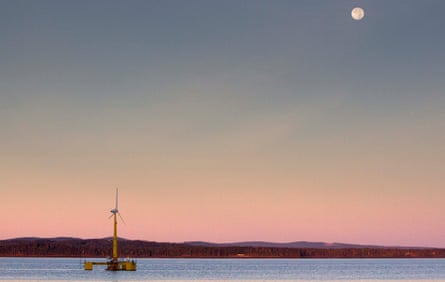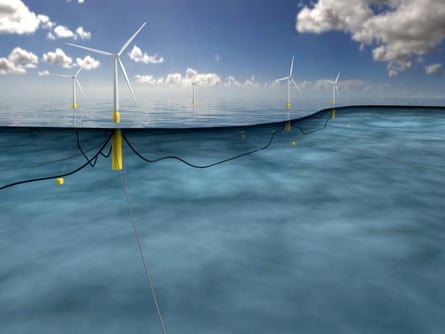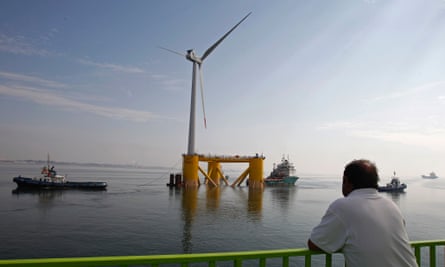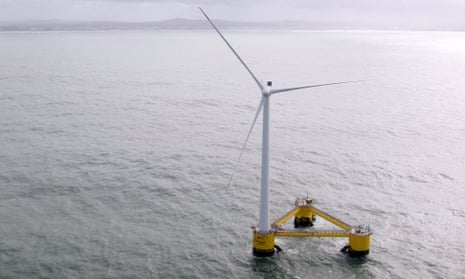Above the inky Atlantic water and beneath a clear blue sky, the giant wind turbine turns gracefully in the steady sea breeze. But the secret of this solitary turbine, sited 5km off the Portuguese coast, lies beneath the gentle swell: it has no foundations and it is floating freely on the ocean, steadied by a triangular yellow platform and decorated by lines of crab-hunting seagulls.
The Windfloat turbine is one of the frontrunners in a global race to develop flotillas of wind turbines that can conquer the deep oceans and reap the strongest winds on the planet. Existing offshore wind turbines, standing on concrete and steel foundations driven into the ocean floor, flounder on heavy costs in depths greater than about 40 metres.
Floating windfarms could play a key role in re-powering Japan, whose love affair with nuclear power ended after the Fukushima disaster, and whose seabed plunges steeply offshore, leaving little space for fixed turbines. The US is also keen, with huge populations near both coasts.
In the UK, home to some of the world's best winds and already hosting the most offshore windfarms, floating turbines could arrive as soon as 2016. Far out to sea, they could also tackle the galeforce antipathy that in some areas have blown out plans for onshore turbines.
Perching a tall windblown tower on a floating platform might seem optimistic, but hundreds of millions of dollars have already been sunk into a menagerie of prototype technologies (see The race to float below) and more than 40 projects are in various stages of development. Most are inspired by rugged oil and gas rigs that have weathered storms for decades.

Pointing out the shells encrusting the legs of the Windfloat platform, Alla Weinstein, chief executive of the US company Principle Power that designed it, joked: “We're thinking of starting a Windfloat mussel business.” But the electrical engineer is deadly serious in her view of the technology's potential: “We are changing the paradigm of offshore wind and making it suitable for any location in the oceans.”
The platform is only the second fullscale floating turbine to be deployed at sea and has survived a brutal winter of storms that blasted Portugal's coast, removing beaches and producing the monstrous wave that English surfer Andrew Cotton tamed in February.
The turbines' blades reach 120m above the sea, stabilised by a three-pillared platform, 35m on each side. The standard 2MW turbine fixed on top has been generating electricity since 2012 and is about to pump out its 10 millionth kilowatt-hour. The rig's legs, extending 20m under the sea, contain ballast water which shifts around to control swaying.
Windfloat has performed well so far and Weinstein is looking ahead to next stage of development.
Principle Power's consortium, which includes the major Iberian energy companies EDP and Repsol, have won a promised €50m of EU support to scale up and deliver three or four huge 6-8MW floating turbines off Portugal by 2017, and are now raising the €100m needed to go ahead. They also aim to have five 6MW turbines in 350m-deep water off Oregon in the US by 2017, aided by $50m for the Department of Energy.
The much bigger turbines will generate more power and hence more money, says Weinstein: “Size really matters in this case.”

Japan is also set to be a big player, with its high population and steeply shelving coasts. “It became a market overnight, after Fukushima, and the Japanese are moving very fast,” says Weinstein. Japan's first floating turbine started operation in November 2013 and the industrial giants of Mitsibushi and Mitsui are both in the race to install 1GW by 2020 – equivalent to a nuclear power station – including 80 turbines off the Fukushima coast.
The floating wind turbine pioneers are surprisingly relaxed about competition. “You can't have an industry with just one company. We need a critical mass for credibility: the more the better,” says Weinstein.
The first fullscale floating turbine – Hywind - went to sea off Stavanger, Norway in 200m-deep water and sent electricity to the grid from 2010. Its design is radically different: a single, very long ballast column sinking 100m below the sea surface. Like Windfloat, it is loosely anchored to the sea bed with mooring lines.
Morton Eeks, from Hywind's developer Statoil, says one feature of the design is a positioning system: "You can remote control it to keep it on the site you want to get the best wind.” Statoil next intends to tow five 6MW turbines to the Buchan Deep, 25km off Peterhead in Scotland, as early as 2016.

Eeks agrees with Weinstein about competition: "What is needed is to see more concepts put into practice: competition will bring the prices down.” Floating wind turbines should benefit from being able to be assembled onshore, then towed to position, avoiding costly bad-weather delays.
Iñigo Palacio Prada, from Spanish energy company Repsol, which has invested in Windfloat as well as windfarms off Scotland, says: “Floating turbines won't be cheaper [to install] than onshore, but you have to go where the best wind is.” Turbines at sea can run 50% more efficiently due to the stronger winds.
Breanne Gellatly, co-leader of the UK Carbon Trust's Offshore Wind Accelerator, says floating wind turbines will be essential in unlocking the offshore wind resource in deeper waters.
She also notes a particularly British advantage: “They can be placed 20 miles offshore and therefore have the advantage of being 'out of sight and out of mind'.” Conservative cabinet minister Eric Pickles has recently blocked a series of onshore windfarms.
The potential is - in theory – great, says Gellatly, noting that two-thirds of the very windy North Sea is between 50m and 220m: “Energy produced from floating turbines in the North Sea alone could meet the EU’s electricity consumption four times over.”
However, Micha Strauss, vice president at Enercon, a German turbine manufacturer that has a large factory at the nearby Portuguese port of Viana do Castelo, disagrees.
The plant turns out hundreds of turbines a year: every one for onshore windfarms. “We don't believe offshore wind is a good business model on cost grounds,” he says. “As long as there is enough land on Earth, we don't need to increase the difficulty of installation by going to sea.”
For politicians, the jobs brought by renewable energy are as important as the power, and Portugal's government – unlike Spain's – was careful to avoid killing investment with retroactive cuts to subsidies. Jorge Moreira da Silva, Portugal's energy and environment minister, told the Guardian: “It isn't just an energy sector, it's an industrial sector, an innovation sector and a regional development sector.”
His aim is to make Portugal a key supplier of green energy to Europe: “We will be able to produce it at lower cost as we have better wind and sun than other countries. It is a win-win: citizens get cheaper energy and it is good for jobs an investment in Portugal too.” He adds: “We can also be a solution to reducing the European reliance on Russian gas.”

Da Silva backs floating wind turbines as part of this: “We really think it can be a cutting-edge solution for coasts like Portugal and California.”
For Thomas Becker, the Danish CEO of the European Wind Energy Association, the commercial viability of floating windfarms will be proven – or not – in the next few years: “But it looks good so far.”
He is scathing about the anti-wind power sentiment of some in the UK. “Maybe they are there, but I can't see the other big industrial ventures that the UK is going to live off in the future,” he says. “One sector where the UK clearly have a great advantage is wind: you have a great resource and great engineers. It is so obvious.”
All agree that the key to launching a global flotilla of floating turbines is driving costs down, with Gellatly estimating the price will have to fall two to four times to reach the same level as fixed turbines.
But the technology is still very young and has survived all the sea can throw at it so far, unlike a predecessor on the very site now occupied by Windfloat. Experimental wave power machines were tested here in 2008 but, in that case, the savage sea won.
The race to float
Three key designs are racing to provide the first commercial floating wind turbines, all adapting technologies proven by the offshore oil and gas industry.
Semi-submersible
A broad platform provides stability by largely lying below the sea surface and using water as ballast. It is loosely anchored to the sea floor. Windfloat has had its full-scale prototype in the ocean off Portugal since 2011 and its 2MW wind turbine is on the brink of generating 10GWh of electricity.
Key companies: Principle Power (US), Mitsubushi (Japan), Mitsui (Japan), DeepCWind (US) Gusto (Netherlands), HiPRwind (Spain)
Tension-leg platform and spar
Spar
A long single column extends far below the water to dampen movement and uses sand and water as ballast. It is also loosely moored to the sea floor. Hywind's fullscale prototype has been generating electricity off Norway since 2010.
Key companies: Hywind/Statoil (Norway), Toda (Japan), Sway (Norway) NauticrAft (Australia), SeaTwirl (Sweden)
Tension-leg platform
A floating platformed is tethered firmly to the sea bed using tensioned cables. BlueH tested a small prototype in 113m of water off Italy in 2008. Turbine can be mounted on the platform onshore, avoiding expensive ships and bad weather delays. It is not suitable for areas with high tidal ranges.
Key companies: BlueH (UK), Gicon (Germany), Pelastar (US), Iberdrola Etorgai (Spain) Mitsui (Japan).
